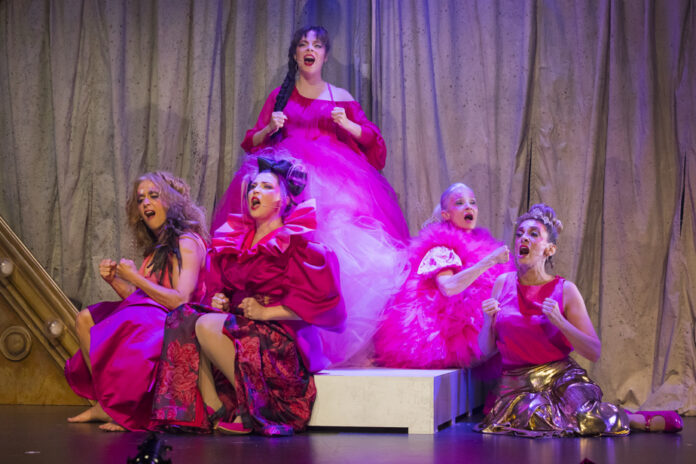“One knit, one purl,” sings Diane Diane Dufresne in Cendrillon au coton. Perfect words to describe Belmont, the astonishing, but scattered, musical show knitted by the Théâtre de l’Oeil Ouvert from the work of the Quebec diva.
The ideator of the project, adapter and director Jade Bruneau (to whom we owe a show on Clémence Desrochers and on La Corriveau) offers with Belmont a real uninhibited trip into the universe of the most rebellious of Quebec singers.
On stage, five women all dressed in pink each represent a facet of this multiple woman that is Diane Dufresne. Laur Fugère embodies the little girl and Catherine Allard, the artist. Laetitia Isambert is the lover, while Geneviève Alarie and Catherine Sénart take on the roles of madwoman and diva respectively. Finally, Pierre-Olivier Grondin wears the clothes of the clown.
These performers convey with aplomb and poise the words of the woman who knew how to bring the crowds together, at the Olympic Stadium, in particular with her mega-show Magie rose. We have an appointment here with six great voices, capable of holding the flights that Dufresne’s repertoire demands. Geneviève Alarie is particularly touching in her interpretation of Parc Belmont. Catherine Sénart is imperial when she interprets Les adieux d’un sex-symbol.
So you don’t have to look at the interpretation, the music delivered on stage by three musicians or the magnificent costumes of Sarah Balleux to find these purl stitches that made us wince.
No, it is rather the very narrative structure of Belmont that is confusing and takes a while to settle in our minds. Jade Bruneau has drawn on all of Diane Dufresne’s work to create the mesh for her show. Here, the songs echo each other, challenge and chase each other… The director has also added here and there excerpts from interviews and very poetic original text by Laurence Régnier.
The result is far from the musical review and even further from the biopic. Jade Bruneau instead decided to create “new form” (the words are hers) for this show: a bold idea, but unfulfilled.
The enigmatic character with the vague contours of the clown also finds its place with difficulty in this feminine polyphony. With his ash gray clothes, he often seems to wander on the stage, carried away by the surge of pink that springs up before our eyes. He loves Dufresne, he says so and we understand him, but he turns on the periphery of the beating heart of the show. To the point of annoying at times, even if the person who embodies him delivers a masterful interpretation of the song Que.
The intensity deployed on stage by the performers (clown included) is undeniable and commands admiration. However, Diane Dufresne’s best-known pieces take time to emerge. And most of the time, the songs are broken up and cut into small bites. We would want them whole, if only to remember their undeniable beauty.
Fortunately, when these grandiose pieces invite themselves on stage for more than a verse, we feel goosebumps run through the entire room. And when the show ends with a cover of Tiens-toé ben j’arrive, we understand that the perfect imperfection of this show is perhaps the best way to represent on stage the elusive and crazy spirit of this icon of the song. Quebec…















